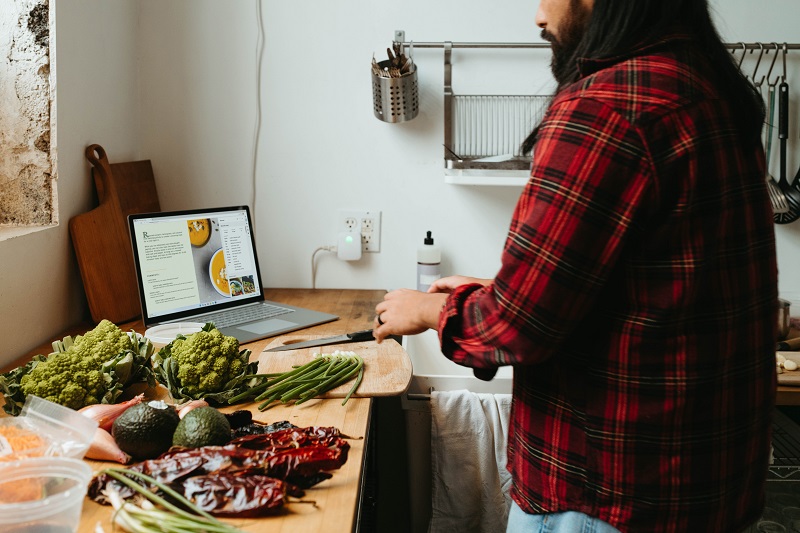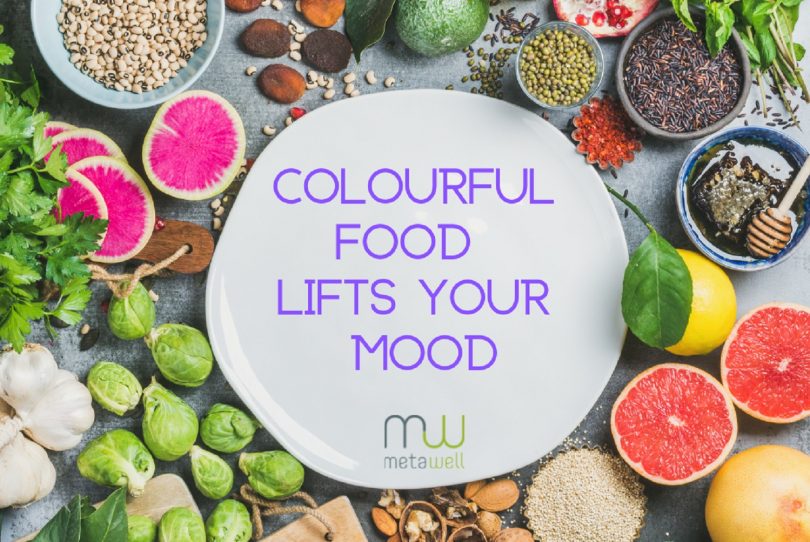Future-proof your mental health with an anti-inflammatory and gut-friendly diet
For happier moods you need to have a happy gut. You can have a happy gut by eating lots of anti-inflammatory foods that feed your beneficial gut bacteria. These foods are colourful vegetables, berries and fruits, beans and lentils, nuts and seeds, herbs and spices, wholegrains (preferably gluten-free), mushrooms and healthy fats. We call these prebiotic foods, meaning they are foods that feed the probiotic bacteria in your gut. The American Gut Project research found that for optimal gut microbiome diversity, we should eat a minimum of 30 different prebiotic foods a week.
It’s also a good idea to support your existing microbes with some added probiotic live bacteria from fermented foods by including into your daily diet small amounts of foods such as yogurt and kefir, sauerkraut and kimchi, kombucha or miso, among other delicious ferments, widely available in supermarkets these days.
Eating a rainbow diet high in these foods has been linked in various studies to greater happiness, better moods and mental health, psychological wellbeing and increased life satisfaction, and may be protective against depression, anxiety, cognitive impairment and dementia.
Omega-3 fats from oily fish and seafood are anti-inflammatory fats that support the structural integrity of your brain and keep your gut healthy. A study with 3,204 Finnish adults showed that the likelihood of having depressive symptoms was significantly higher among infrequent fish consumers than among frequent consumers. Having higher omega-3 status in red blood cells may also improve the response to standard antidepressant medication in depressed subjects, as shown in a study with 60 depressed adults with major depressive disorder.
Regardless of whether you are taking antidepressant medication or not, including several portions of oily ‘SMASH’ fish (salmon, mackerel, anchovies, sardines, herring) in your weekly meals can be a great strategy to improve your brain and mental health.
And… You can also have your chocolate and eat it! A small randomised control trial found that a 30g daily intake of 85% dark chocolate reduced anxiety and depression and improved quality of life. The group that consumed the same amount of 70% chocolate did not show this benefit. Furthermore, gut microbial diversity was significantly higher in the 85% chocolate consumer group than in the control group who didn’t consume any chocolate. Dark chocolate is a prebiotic food so it feeds your beneficial bacteria, and may improve the diversity and composition of the gut microbiome. This in turn may improve mood via the gut-brain axis. So go ahead and treat yourself! Just remember it has to be the dark stuff!
Can it be done on a budget?
So now that you know what you need to eat to keep your gut and yourself happy, you might be thinking that it’s going to cost you a lot.
But it doesn’t have to!
Yes, processed foods can often be a cheaper, but if they don’t keep you full for long and will make you eat more, you are not saving money in the long run. One thing for certain is that if you start eating real food and a rainbow diet and when you prioritise a healthy balanced breakfast over cereal or toast to start your day, you will feel fuller for longer, have fewer cravings and need fewer snacks during the day. This of course is good for your purse too!

Here are some key strategies for eating healthily on a budget:
- Prioritise a healthy balanced breakfast – Always include a good amount of protein, colourful veggies/fruits and some healthy fats. You will be fueling your body well for the day ahead after a long overnight fast, and you’ll have stable energy and moods, and won’t have cravings or constant urges to snack! Sugary cereals, or toast and honey just won’t cut it as breakfast!
- Stock up your freezer, fridge and cupboards with healthy food, such as tinned beans, fish, tomatoes; jars of vegetables; frozen vegetables, berries and fish; dried beans and lentils, wholegrains such as rice, oats, buckwheat, quinoa, dried spices and herbs; eggs, tofu and miso, bagged salads, nuts and seeds…. These are all convenient and easy to use to rustle up tasty meals any time.
- Cook from scratch – Learn a few basic recipes such as stews, soups, pasta sauces, curries, traybakes and salads that include a variety of veg, cheaper cuts of meat or pulses for protein. Start batch-cooking and you will have food ready for meals for the days ahead, and it will take some pressure off your shoulders when you are busy and will save money in the long run.
- Plan ahead for the week – When you meal plan you are less likely to grab a spur-of-the-moment ready-meal or call for a takeaway. Create a 2-hour slot in your diary each week for planning your weekly meals and prepping some of them ahead.
- Eat in season (and locally grown whenever possible) – Seasonal food is often cheaper and more nutrient-rich, and always tastier in my mind. Studies also suggest that in-season consumption of foods leads to better health outcomes compared to out-of-season consumption, which may create metabolic dysregulation in the body.
- Avoid wasting food – Many people don’t use all parts of vegetables that can be eaten and are often the most nutritious and tasty. You can use cauliflower leaves, broccoli stalks, outer leaves of lettuces, the skin of squashes and fruit peel (just wash it well), to name a few. Freeze meat bones and chicken carcasses until you’ve got enough for making your own bone stock/broth for gut-healing soups and sauces. Also, if you are a meat eater, learn to eat “nose-to-tail” and cook less popular cuts of meats, like liver and other organ meats, and tougher cuts that need slow cooking. These are usually the cheapest of cuts and highly nutritious.
Healthy eating on a budget is indeed possible but does require some thought, effort and planning, but it really doesn’t have to break the bank. Start focusing on small daily/weekly healthy habits and one small change at a time, and build on that. You don’t have to do it all from the get-go. One extra vegetable/colour on your breakfast plate or one new recipe each week could be a good start.
And remember that managing your stress levels, moving your body, connecting with nature and prioritising your sleep are foundations of optimal health and crucial for gut health and mental wellbeing, and best of all, don’t cost a penny, so include more than just dietary changes in your health plan.
To read more about how your gut health affects your mood, download my free ‘Happy Gut – Happy You’ guide here.
My final tips for future-proofing your mental health:
- Reduce or eliminate refined processed foods.
- Ensure good hydration.
- Manage your stress better.
- Chew every mouthful well.
- Choose quality over quantity when buying food.
- Count colours not calories.
- Aim for 30 different plant foods a week.
- Try some fermented probiotic foods.
- Educate your tastebuds to accept fewer sweet tastes by eating more bitter foods.
- Ensure that you are eating enough good quality protein and healthy fats.
And most of all enjoy your food!
Previous article: How to eat for good mood and mental wellbeing – part 1
References
Saghafian F et al. Fruit and vegetable consumption and risk of depression: accumulative evidence from an updated systematic review and meta-analysis of epidemiological studies. Br J Nutr. 2018 May;119(10):1087-1101. doi: 10.1017/S0007114518000697. PMID: 29759102. https://pubmed.ncbi.nlm.nih.gov/29759102/
McDonald D. et al., American Gut: an Open Platform for Citizen Science Microbiome Research. mSystems. 2018 May-Jun; 3(3) https://www.ncbi.nlm.nih.gov/pmc/articles/PMC5954204
Wu S, Fisher-Hoch SP et al. Association between fruit and vegetable intake and symptoms of mental health conditions in Mexican Americans. Health Psychol. 2018 Nov;37(11):1059-1066. doi: 10.1037/hea0000646. Epub 2018 Oct 8. PMID: 30299120; PMCID: PMC6188785. https://pubmed.ncbi.nlm.nih.gov/30299120/
Tanskanen A et al. Fish consumption and depressive symptoms in the general population in Finland. Psychiatr Serv. 2001 Apr;52(4):529-31. doi: 10.1176/appi.ps.52.4.529. PMID: 11274502. https://pubmed.ncbi.nlm.nih.gov/11274502/
Cussotto S et al. Low omega-3 polyunsaturated fatty acids predict reduced response to standard antidepressants in patients with major depressive disorder. Depress Anxiety. 2022 May;39(5):407-418. doi: 10.1002/da.23257. Epub 2022 Mar 31. PMID: 35357051. https://pubmed.ncbi.nlm.nih.gov/35357051/
Shin JH et al. Consumption of 85% cocoa dark chocolate improves mood in association with gut microbial changes in healthy adults: a randomized controlled trial. J Nutr Biochem. 2022 Jan;99:108854. doi: 10.1016/j.jnutbio.2021.108854. Epub 2021 Sep 14. PMID: 34530112. https://pubmed.ncbi.nlm.nih.gov/34530112/
Arola A, et al. Chrononutrition and Polyphenols: Roles and Diseases. Nutrients 2019, 11(11), 2602. https://www.ncbi.nlm.nih.gov/pmc/articles/PMC6893786/
Main photo by KLIV BRAND on Unsplash



